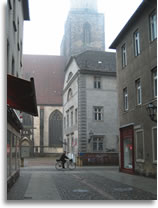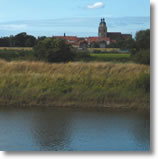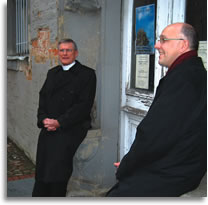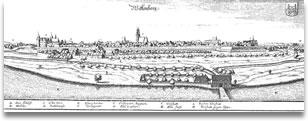by Paula Schlueter Ross
Wittenberg. This picturesque German town, situated on the Elbe River about an hour’s train ride south of Berlin, is where Martin Luther taught as a professor, preached in the Town Church, and ignited the Reformation by posting his 95 Theses on the door of the Castle Church.
 |
A bicyclist passes the grey “Old Latin School” building , built in 1564 and purchased for use as a ministry center. It is only steps from the front door of St. Mary’s, the town church (in the background).Photo courtesy David Mahsman |
Wittenberg was Luther’s home for 36 years. It’s where he proclaimed God’s Gospel of forgiveness and eternal life for all—by grace alone, through faith alone, in Christ alone, on the basis of Scripture alone.
Today, nearly 500 years later—in the wake of oppression first by Nazism, then by Communism—only about 15 percent of the town’s 50,000 residents say they are Christian.
Enter The Lutheran Church— Missouri Synod and its German partner, the Independent Evangelical Lutheran Church (known by its German abbreviation, SELK). Working together, the two church bodies hope to renovate the “Old Latin School,” a four-story high school built in 1564 that has been vacant for some 16 years and is just steps from St. Mary’s Church—Luther’s Stadtkirche, or Town Church.
The idea is to renovate the school as a new Lutheran ministry center sometime before the 500th anniversary of the Reformation in 2017.
A detailed ministry plan is being developed. The original vision for the “Wittenberg project” includes the following:
- Re-establishing a German-language SELK congregation—to reach out to the town’s non-Christians with the Gospel of Jesus Christ
- An “International Lutheran Welcome Center”—to give tourists an opportunity to learn more about Martin Luther, the Reformation, and, most important, the Gospel that Luther and the other reformers restored to the Church
- A place for theological study— to enable Lutheran pastors, students, and laypeople to deepen their understanding of Reformation events, people, and theology
 |
St. Mary’s, the town church, is a prominent landmark as visitors approach Wittenberg from the south, across the Elbe River on which the town was built.Photo courtesy David Mahsman |
Both the SELK and the LCMS “believe that it is important that our churches and the theological confession for which we are known around the world be represented in Wittenberg, the birthplace of the Reformation,” says Dr. Samuel H. Nafzger, new chairman of the supervisory board of the International Lutheran Society of Wittenberg (ILSW). The ILSW, a non-profit German corporation and a Recognized Service Organization of the LCMS, was established in 2007 to operate the Wittenberg project on behalf of the two church bodies. (See the October 2007 issue of The Lutheran Witness.)
Nafzger was named to the post July 22, succeeding SELK Bishop Hans-Jörg Voigt, who said he stepped down as the board’s chairman “to advance this important project, putting the leadership into the hands of our American brethren.” Voigt called Nafzger “ideally suited for the position” and “one of the leading theologians of the LCMS.”
Voigt, who pledged to continue his support for the Wittenberg project “with all my heart,” characterized it as “not only meaningful, but necessary.”
Also at its July meeting, the board named Rev. David L. Mahsman to succeed Dr. Wilhelm Torgerson, who is retiring as the ILSW’s managing director.
After serving four years as assistant to the executive director of LCMS World Mission, Mahsman began serving July 1 as director, special assignments, Eurasia, for LCMS World Mission. He will continue in that post as well.
 |
LCMS President Gerald B. Kieschnick, left, and SELK Bishop Hans-Jörg Voigt visit in March at the front door of the historic Wittenberg building.Photo courtesy David Mahsman |
Torgerson expressed high regard for his successor’s background, noting especially his years of service as a church journalist. Mahsman was for 20 years the Missouri Synod’s director of news and information and executive editor of its two official periodicals, The Lutheran Witness and Reporter.
“I am looking forward to getting to know the Wittenberg community and its leaders, to developing many positive relationships, and finding ways to implement the goals that led to the founding of the ILSW by our two church bodies,” says Mahsman, who is now based in Wittenberg.
The 16th-century school building that will become the new Lutheran ministry center was purchased by the ILSW with a donation from the LCMS Central Illinois District Church Extension Fund. The project got its start from the SELK, LCMS World Mission, LCMS World Relief and Human Care, and Concordia Publishing House.
The Synod and the SELK hope that some $4 million can be raised to renovate the building, which needs a new roof, a new stucco façade, new windows and doors, an elevator, new stairways, new heating and air systems, and inside furnishings.
The Wittenberg project is a formidable undertaking, but one with special opportunities, according to Mahsman. Not only will the Gospel be shared with the town’s residents and hordes of tourists, but Lutherans can “gain a stronger, more confident Lutheran identity, and strengthen their own witness to Christ.”
Adds Mahsman: “There is no better place for this to happen than in Wittenberg.”
Wittenberg Then
by Robert Rosin
 |
In 1517, Wittenberg was a modest medieval town with a new university at the intersection of ancient routes in northern Europe. Yet, by the grace of God, from this unremarkable backwater on the Elbe River flowed a theological and intellectual revolution that changed the world.Early 17th-century engraving of Wittenberg by Matthäus Merian courtesy Al Collver |
Wittenberg—“White Mountain”—was, in truth, little more than a sand hill along the Elbe River flowing toward the Baltic Sea. From the mid-12th century, it guarded trade routes intersecting there, developing into a local devotional site for pilgrims and serving as a governmental center for Saxony-Wittenberg. The city’s stature grew when the Saxon prince became one of seven voters who elected the Holy Roman Emperor, who ruled not Rome but the German lands.
In 1485, Saxony was divided between brothers Albert and Ernest. Ducal Saxony, including the territory’s university in Leipzig, went to Albert, while Ernest’s portion retained the vote for the emperor—hence Electoral Saxony. His son Frederick (“the Wise”) wanted to educate his professionals at home, so Wittenberg University opened in 1502.
Scholasticism had long dominated late medieval universities, using syllogistic logic from Aristotle to unpack everything, including theology. Renaissance humanism (not to be confused with modern secular humanism) offered a rival approach, using the classical liberal arts. When the new university’s charter called for teaching “posy and the arts,” Wittenberg stood ready to usher in a new era.
Luther entered monastic life in 1505 and began studying theology in 1507, arriving in Wittenberg to finish his doctorate in 1511 before staying on as a professor of biblical theology at the university. When biblical languages and history helped him discover the Gospel and understand God’s working in history to save His people, he rejected Scholasticism and pressed to emphasize the liberal arts in Wittenberg’s curriculum.
As a result, students flocked to Wittenberg even before the evangelical Reformation further swelled the ranks. The city itself had about 2,000–2,500 residents and was roughly eight blocks long and four blocks wide. Elector Frederick replaced the old fortress with a Renaissance-era castle at one end of town, along with a church that housed one of the grandest relic collections north of the Alps. (The doors from the Ninety-five Theses were burned later, in 1760, during the Seven Years’ War. Actually, the whole church was badly damaged. That’s why today the Castle Church is whitewashed on much of the interior—to hide the smoke and fire damage.)
Near the other end of town, Frederick built a cloister for the Augustinians, who promised to provide theology professors in exchange. That’s how Luther got there. A new university building stood a few steps away, though Luther lectured in the cloister. And at the center of Wittenberg, St. Mary’s Church served the townsfolk, with Luther regularly filling the pulpit. (He is buried, however, in the Castle Church, just in front of the pulpit.)
One historian called Wittenberg “Academic Siberia,” and Luther would agree the place was modest at best. Although the university was moved to Halle in 1817, in Luther’s day Wittenberg became the focal point of a theological revolution. It’s all still there to see, even as the Reformation message goes on.





